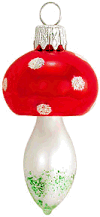How Do Reindeer Fly?

… and how can Santa Claus visit every house, go down chimneys, leave toys, all over the world in one night?
One of the answers is found on European Christmas trees.
Read about Finland’s version of the Julbock, Joulupukki.
Note: Don’t try this at home unless you have the kidneys of a reindeer. It also explains why gnomes are so cheerful. [This is one of my most searched for posts, almost as big as the Shi’ia oil map, or the Alaska-Russia border. It is a bit disconcerting to see the number of people around the world whose interests are as weird as mine, but they are all hits on the counter.]



































4 comments
I wonder at what strange process turned that into balls on American holiday trees? (There, I said “holiday tree”, I made Rush Limpthingy cry!). And, specifically, balls of *glass*? A commentary on American manhood? 😈
– Badtux the Snarky Penguin
It is very traditional on German ‘fir trees’ [that is what Tannenbaum means, not Christmas tree] along with birds and candles. As evergreens they were part of the pre-Christian winter solstice celebration, and the connection with Christmas was contrived to get the priests off their backs during the continuing celebration of ‘pagan’ holidays.
The ‘religious’ ornaments are generally for export in Germany, and not used in country. The whole American custom was started by Prince Albert [Victoria’s hubby] and then exported to the US towards the end of the 19th century.
The custom was observed in areas of German settlement in the US, but it didn’t become mainstream until Victoria and Albert made it an upper class custom in Britain.
Fly agaric was a common ‘medicine’ among Northern European ‘wise men and women’, as was ergot [proto-LSD].
Fir trees are perfect for reminding one to sing that old seasonal favorite, “Come on baby, light my fire…”
They are a bonfire in waiting, especially in Germany where candles are used instead of lights.